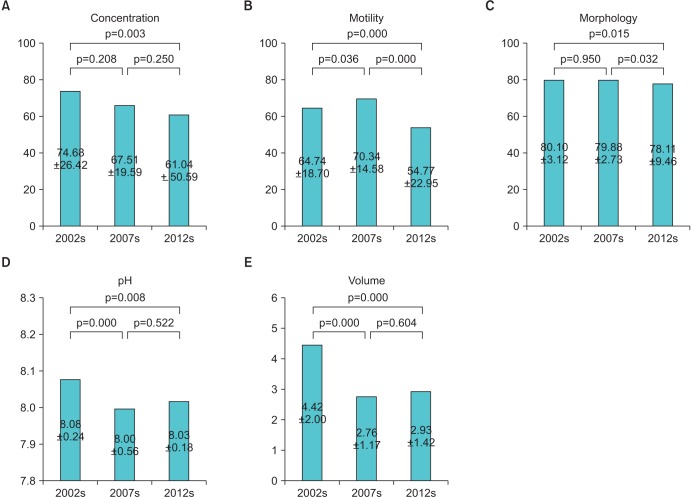Korean J Urol.
2015 Dec;56(12):831-836. 10.4111/kju.2015.56.12.831.
Semen parameters from 2002 to 2013 in Korea young population: A preliminary report
- Affiliations
-
- 1Department of Urology, National Police Hospital, Seoul, Korea. drmsk@korea.com
- KMID: 2359876
- DOI: http://doi.org/10.4111/kju.2015.56.12.831
Abstract
- PURPOSE
To analyze the differences of semen parameters in Korean young population for three periods from 2002 to 2013.
MATERIALS AND METHODS
A total of 516 semen samples were collected from Korean men presenting for infertility, varicoceles or other infectious problems for three periods from 2002 to 2012: January 2002-December 2003, January 2007-December 2008, and January 2012-December 2013. A standard World Health Organization procedure for semen analysis was performed for assessment of semen concentration, volume, motility, morphology, and pH.
RESULTS
A total of 160, 162, 194 men constituted the study populations in 2002 to 2003, in 2007 to 2008, and in 2012 to 2013, respectively. The overall sperm parameter results suggested a statistically significant difference between 2002 to 2003 and 2012 to 2013 except pH. However, considering the data from 2007 to 2008, there were no trends in changes in overall semen parameters. Negative correlations were observed in all semen parameters with increasing age in all patients, except for pH. In addition, semen volume, motility, and morphology had higher negative correlation coefficients with age, from 2002 to 2013, serially.
CONCLUSIONS
There were no significant changes in the semen parameters of Korean men from 2002 to 2013. In addition, semen volume, motility, and morphology showed higher negative correlation coefficients with age from 2002 to 2013, serially.
Keyword
MeSH Terms
Figure
Reference
-
1. Cooper TG, Noonan E, von Eckardstein S, Auger J, Baker HW, Behre HM, et al. World Health Organization reference values for human semen characteristics. Hum Reprod Update. 2010; 16:231–245. PMID: 19934213.
Article2. Nelson CM, Bunge RG. Semen analysis: evidence for changing parameters of male fertility potential. Fertil Steril. 1974; 25:503–507. PMID: 4835605.
Article3. Carlsen E, Giwercman A, Keiding N, Skakkebaek NE. Evidence for decreasing quality of semen during past 50 years. BMJ. 1992; 305:609–613. PMID: 1393072.
Article4. Swan SH, Elkin EP, Fenster L. Have sperm densities declined? A reanalysis of global trend data. Environ Health Perspect. 1997; 105:1228–1232. PMID: 9370524.
Article5. Becker S, Berhane K. A meta-analysis of 61 sperm count studies revisited. Fertil Steril. 1997; 67:1103–1108. PMID: 9176451.
Article6. Seo JT, Rha KH, Park YS, Lee MS. Semen quality over a 10-year period in 22,249 men in Korea. Int J Androl. 2000; 23:194–198. PMID: 10886420.
Article7. World Health Organization. WHO laboratory manual for the examination of human semen and semen-cervical mucus interaction. 4th ed. Cambridge: Cambridge University Press;1999.8. World Health Organization. WHO laboratory manual for the examination of human semen and semen-cervical mucus interaction. 5th ed. Cambridge: Cambridge University Press;2010.9. Murray KS, James A, McGeady JB, Reed ML, Kuang WW, Nangia AK. The effect of the new 2010 World Health Organization criteria for semen analyses on male infertility. Fertil Steril. 2012; 98:1428–1431. PMID: 22921910.
Article10. Chen Z, Toth T, Godfrey-Bailey L, Mercedat N, Schiff I, Hauser R. Seasonal variation and age-related changes in human semen parameters. J Androl. 2003; 24:226–231. PMID: 12634309.
Article11. Baker K, Li J, Sabanegh E Jr. Analysis of semen parameters in male referrals: impact of reference limits, stratification by fertility categories, predictors of change, and comparison of normal semen parameters in subfertile couples. Fertil Steril. 2015; 103:59–65.e5. PMID: 25450301.
Article12. Henderson BE, Benton B, Jing J, Yu MC, Pike MC. Risk factors for cancer of the testis in young men. Int J Cancer. 1979; 23:598–602. PMID: 37169.
Article13. Agarwal A, Virk G, Ong C, du Plessis SS. Effect of oxidative stress on male reproduction. World J Mens Health. 2014; 32:1–17. PMID: 24872947.
Article14. De Rosa M, Zarrilli S, Paesano L, Carbone U, Boggia B, Petretta M, et al. Traffic pollutants affect fertility in men. Hum Reprod. 2003; 18:1055–1061. PMID: 12721184.15. Selevan SG, Borkovec L, Slott VL, Zudova Z, Rubes J, Evenson DP, et al. Semen quality and reproductive health of young Czech men exposed to seasonal air pollution. Environ Health Perspect. 2000; 108:887–894. PMID: 11017895.
Article16. Mukhopadhyay D, Varghese AC, Pal M, Banerjee SK, Bhattacharyya AK, Sharma RK, et al. Semen quality and agespecific changes: a study between two decades on 3,729 male partners of couples with normal sperm count and attending an andrology laboratory for infertility-related problems in an Indian city. Fertil Steril. 2010; 93:2247–2254. PMID: 19328484.
Article17. National Institute of Environmental Research. Emission statistics [Internet]. Incheon: National Institute of Environmental Research;c2009. cited 2015 Oct 5. Available from: http://airemiss.nier.go.kr/nape/statistics/airpollution/pollutants/retrieve.jsp?mm=2&sm=1&ssm=1.18. Kidd SA, Eskenazi B, Wyrobek AJ. Effects of male age on semen quality and fertility: a review of the literature. Fertil Steril. 2001; 75:237–248. PMID: 11172821.
Article19. Statistics Korea. Vital statistics [Internet]. Daejeon: Statistics Korea;2015. cited 2015 Oct 5. http://kostat.go.kr.
- Full Text Links
- Actions
-
Cited
- CITED
-
- Close
- Share
- Similar articles
-
- Scrotal Hypothermia in the Infertile Men
- The Effects of Isotypes and Regional Distribution of Antisperm Antibodies on Semen Parameters and Fertilizing Ability
- Studies on Liquefaction of Human Semen
- Monthly variations in semen parameters in a Sri Lankan population undergoing fertility evaluation
- Is There a Decrease in Semen Parameters among Korean Men?


